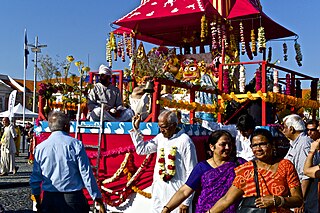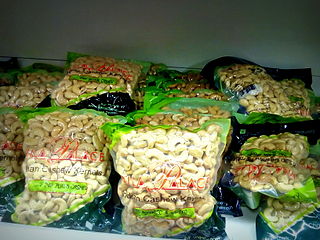
Mozambique, officially the Republic of Mozambique, is a country located in southeastern Africa bordered by the Indian Ocean to the east, Tanzania to the north, Malawi and Zambia to the northwest, Zimbabwe to the west, and Eswatini and South Africa to the southwest. The sovereign state is separated from the Comoros, Mayotte and Madagascar by the Mozambique Channel to the east. The capital and largest city is Maputo.
Mozambique was a Portuguese colony, overseas province and later a member state of Portugal. It gained independence from Portugal in 1975.

Portuguese Mozambique or Portuguese East Africa were the common terms by which Mozambique was designated during the period in which it was a Portuguese colony. Portuguese Mozambique originally constituted a string of Portuguese possessions along the south-east African coast, and later became a unified colony, which now forms the Republic of Mozambique.

The economy of Mozambique is $14.396 billion by gross domestic product as of 2018, and has developed since the end of the Mozambican Civil War (1977–1992). In 1987, the government embarked on a series of macroeconomic reforms, which were designed to stabilize the economy. These steps, combined with donor assistance and with political stability since the multi-party elections in 1994, have led to dramatic improvements in the country's growth rate. Inflation was brought to single digits during the late 1990s, although it returned to double digits in 2000–02. Fiscal reforms, including the introduction of a value-added tax and reform of the customs service, have improved the government's revenue collection abilities.
The Memon are a Muslim community in Gujarat India, and Sindh, Pakistan, the majority of whom follow the Hanafi fiqh of Sunni Islam. They are divided into different groups based on their origins: Kathiawari Memons, Kutchi Memons and Bantva Memons from the Kathiawar, Kutch and Bantva regions of Gujarat respectively, and Sindhi Memons from Sindh.

The Makua people, also known as Makhuwa or Wamakua, are a Bantu ethnic group found in northern Mozambique and the southern border provinces of Tanzania such as the Mtwara Region. They are the largest ethnic group in Mozambique, and primarily concentrated in a large region to the north of the Zambezi River.
Saraswat Brahmins are Hindu Brahmins, who are spread over widely separated regions spanning from Kashmir in North India to Konkan in West India to Kanara and Kerala in South India. The word Saraswat is derived from the Rigvedic Sarasvati River.

Paradesi Jews immigrated to the Indian subcontinent during the 15th and 16th centuries following the expulsion of Jews from Spain. Paradesi refers to the Malayalam word that means foreign as they were newcomers. These Sephardic immigrants fled persecution and death by burning in the wake of the 1492 Alhambra decree expelling all Jews who did not convert to Christianity from Spain, and King Manuel's 1496 decree expelling Jews from Portugal. They are sometimes referred to as "White Jews", although that usage is generally considered pejorative or discriminatory and refers to relatively recent Jewish immigrants, predominantly Sephardim.
The Gujarati people, or Gujaratis, are an Indo-Aryan ethnolinguistic group who reside in or can trace their ancestry or heritage to a region of the Indian subcontinent primarily centered in the present-day western Indian state of Gujarat. They primarily speak Gujarati, an Indo-Aryan language. While Gujaratis mainly inhabit Gujarat, they have a diaspora worldwide. Gujaratis in India and the diaspora are prominent entrepreneurs and industrialists and maintain high social capital. Many notable independence activists were Gujarati, including Mahatma Gandhi, Muhammad Ali Jinnah, and Vallabhbhai Patel.
Goans is the demonym used to describe the people native to Goa, India, who form an ethno-linguistic group resulting from the assimilation of Indo-Aryan, Dravidian, Indo-Portuguese, and Austro-Asiatic ethnic and/or linguistic ancestries. They speak different dialects of the Konkani language, collectively known as Goan Konkani. "Goanese" is an incorrect term for Goans.

There is relatively little history of active practice of Hinduism in Portugal. Presently there is a Hindu community of approximately 9,000 persons, which largely traces its origins to Indians who emigrated from the former Portuguese colonies of Lusophone Africa, particularly from Mozambique, and from the former colony of Diu, Daman and Goa and other possessions in Portuguese India.

Mozambique has a historic Hindu community. Some of their ancestors came to Mozambique at least 500 years ago. Predating their economic participation in Mozambique before the arrival of Vasco da Gama, they adapted during the Portuguese colonial rule. An exodus began during the civil war between 1975 and 1990. After 1990 political and social reforms in Mozambique, the Hindu community along with the other minority religions, have once again begun to become vibrant.
The Indian diaspora in Southeast Africa consists of approximately 3 million people of Indian origin. Some of this diaspora in Southeast Africa arrived in the 19th century from British India as indentured labourers, many of them to work on the Kenya–Uganda railway. Others had arrived earlier by sea as traders.
The term Gujarati Muslim is usually used to signify an Indian Muslim from the state of Gujarat in western coast of India. Most Gujarati Muslims have Gujarati language as their mother tongue, but some communities such as the Soomra & Sindhi have Kutchi other like Momin Ansari, Memons, Charotar Vahora & Vohra Gujarati Shaikh (Hansotis) and others, have Urdu as their mother tongue. The majority of Gujarati Muslims are Sunni, with a minority of Shi'ite groups.

There are currently over 60,000 people of Indian origin in Tanzania. Many of them are traders and they control a sizeable portion of the Tanzanian economy. Indians have a long history in Tanzania starting with the arrival of Gujarati traders. They came to gradually control the trade in Zanzibar. Many of the buildings constructed then still remain in Stone Town, the focal trading point on the island.
Indian Ocean trade has been a key factor in East–West exchanges throughout history. Long-distance trade in dhows and proas made it a dynamic zone of interaction between peoples, cultures, and civilizations stretching from Southeast Asia to East and Southeast Africa and East Mediterranean in the West in prehistoric and early historic periods. Cities and states on the Indian Ocean rim focused on both the sea and the land.
The Indians in China are migrants from India to China and their descendants. Historically, Indians played a major role in disseminating Buddhism in China and influencing Taoism indirectly. In modern times, there is a large long-standing community of Indians living in Hong Kong, often for descendants with several generations of roots and a growing population of students, traders and employees in Mainland China. The majority of Indians are East Indian Bengali, Bihari as well as a high proportion of North Indians.

Afro-Asians are African communities that have been living in the Indian Subcontinent for centuries and have settled in countries such as India, Pakistan and Sri Lanka.
Luso-Asians are people whose ethnicity is partially or wholly Portuguese and ancestrally are based in or hail primarily from Portugal, South Asia, Southeast Asia, and East Asia. They historically came under the cultural and multi-ethnic sway of the Portuguese Empire in the East and retain certain aspects of the Portuguese language, Roman Catholic faith, and Latin cultural practices, including internal and external architecture, art, and cuisine that reflect this contact. The term Luso comes from the Roman empire's province of Lusitania, which roughly corresponds to modern Portugal.

The Cashew business in Kollam is based in the eponymous city, which is known as the Cashew Capital of the World. Kollam is the largest processed cashew exporter in the world. As of 2011 there were more than 600 cashew processing units in the city. About 800,000 tonnes of raw cashews are imported to the city for processing every year. 80% of India's export quality cashew kernels were prepared in Kollam. Kollam has remained the cashew capital of the world since the 1930s.










